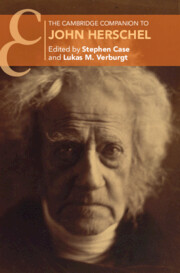Book contents
- The Cambridge Companion to John Herschel
- The Cambridge Companion to John Herschel
- Copyright page
- Contents
- Figures
- Contributors
- Acknowledgments
- Chronology
- Introduction
- 1 John Herschel
- 2 The Mathematical Journey of John Herschel
- 3 John Herschel’s Astronomy
- 4 Stargazer at World’s End
- 5 Herschel’s Philosophy of Science
- 6 Drawing Observations Together
- 7 Photology, Photography, and Actinochemistry
- 8 Herschel’s Planet
- 9 John Herschel and Scientific Standardization
- 10 John Herschel and Politics
- 11 John Herschel’s Methodology in the Scientific Community
- Further Reading
- Index
7 - Photology, Photography, and Actinochemistry
The Photographic Work of John Herschel
Published online by Cambridge University Press: 08 May 2024
- The Cambridge Companion to John Herschel
- The Cambridge Companion to John Herschel
- Copyright page
- Contents
- Figures
- Contributors
- Acknowledgments
- Chronology
- Introduction
- 1 John Herschel
- 2 The Mathematical Journey of John Herschel
- 3 John Herschel’s Astronomy
- 4 Stargazer at World’s End
- 5 Herschel’s Philosophy of Science
- 6 Drawing Observations Together
- 7 Photology, Photography, and Actinochemistry
- 8 Herschel’s Planet
- 9 John Herschel and Scientific Standardization
- 10 John Herschel and Politics
- 11 John Herschel’s Methodology in the Scientific Community
- Further Reading
- Index
Summary
By January 1839, when the daguerreotype was first made public, John Herschel had long been familiar with the basic chemical and optical components necessary to begin his own photographic experiments. His use of visual expression in his observations, combined with his experiments on chemistry, light, and optics, had begun two decades or more before Louis Jacques Mandé Daguerre (1787–1851) and William Henry Fox Talbot (1800–77) made their respective claims to photographic invention. Because Herschel’s photography has been studied largely through the lens of the history of photography, discussions are often inflected by various origin stories that privilege, for better or worse, the creation of recognizable, fixed images. This frame truncates the full and lifelong series of experiments that were eventually to become Herschel’s “photography,” which became a collective heading under which he consolidated his chemico-optical experiments, gathering them into a single strand of research that began as early as the 1810s and persisted through the end of the 1850s. In this extensive group of experiments, Herschel made systematic use of photography for spectral analysis and chemical sensitometric testing long before the photo-chemical work of Henry Roscoe (1833–1915) and Robert Bunsen (1811–99) in Manchester and even longer before Ferdinand Hurter (1844–98) and Vero Charles Driffield (1848–1915), who between them established important benchmarks in the nascent field of photochemistry and sensitometry.1 Signaling that he recognized the direction his experiments on light were taking away from trends in photography by the 1850s, Herschel renamed his use of photography for light experiments “actino-chemistry,” differentiating it from making optical images.2
- Type
- Chapter
- Information
- The Cambridge Companion to John Herschel , pp. 160 - 185Publisher: Cambridge University PressPrint publication year: 2024



